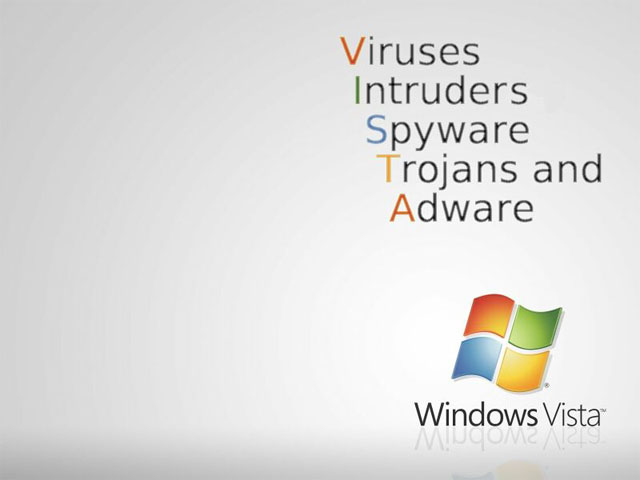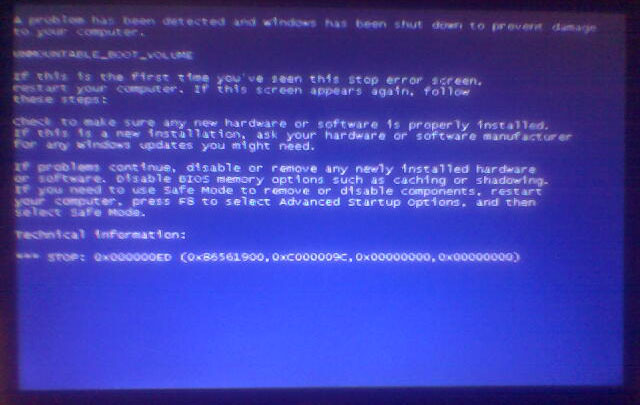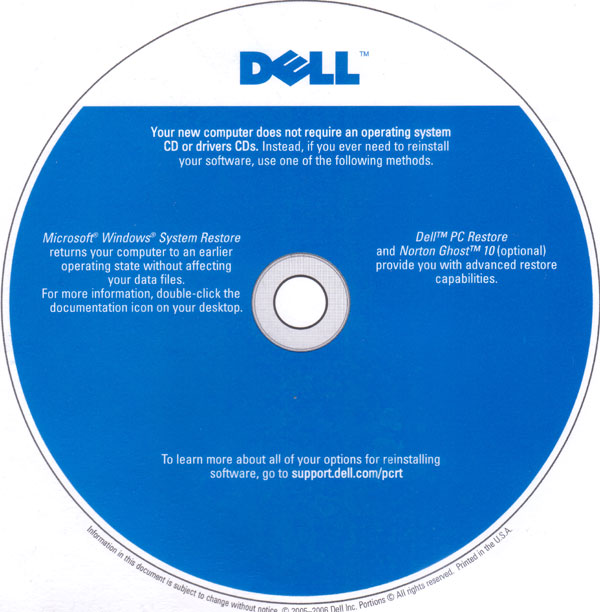The inevitable release of Windows Vista has finally arrived, and I must say… I couldn’t care less. I can nearly guarantee that this is an operating system I’ll never use personally, and hopefully I won’t ever have to interact with it professionally, either.
I couldn’t help but share this humorously predictive image, from Nick Scipio‘s site:

(I usually check out Nick’s Picture of the Day as part of my daily reading.)
As part of the hype-building for Vista’s launch, Bill Gates appeared on The Daily Show last night. The predominant thought I had while watching his interview was just how uncomfortable and downright dorky Gates remains after all of these years.
I guess I just find it really odd to see a stereotypical computer geek with an awkward laugh and clumsy mannerisms who has achieved as much notoriety and has had such an unquestionable effect on the world as Gates has. You’d think he would’ve acquired some social skills by now. Then again, you’d think his company would’ve learned a few things by now, too. So it goes.
A brief prologue to this entry: I really wanted to include a link to the Onion column “Walken in LA,” but was unable to find it. I can only assume that they were asked to take it down by Christopher Walken or an agent or publicist of his, which is very unfortunate. I am pretty sure the column appeared in this issue, but it doesn’t show up there anymore. It still exists in blatantly stolen form in various places throughout the Internet, and is easy to find, but for some reason it’s just not the same. Any information leading to the actual location on the Internet of this column would be greatly appreciated.
I recently ordered a product called the Hot Diggity Dogger, which bills itself as “The World’s Greatest Hot Dog Maker.”
It arrived earlier this week, and I brought it to my office for use on a daily basis. I really like hot dogs. During my senior year of college, my roommate Zelle and I would buy monster 80-packs of hot dogs from Sam’s Club and eat them every day for lunch. Lesser men might get sick of eating the same thing every day, but not us. I now plan to apply that same “all hot dogs, all the time” policy to workday lunches.
My initial experience was quite good. The Hot Diggity Dogger makes dogs that taste a lot more like they are fresh off the grill than one might expect, and makes the buns warm and just crispy enough for my liking. Not only is it much cheaper to stock hot dogs and buns at work than it is to go out to eat every day, but I feel like the convenience of being able to prepare and eat a meal without leaving my office helps keep me focused and perhaps even a little more productive. As I said, though, I really like hot dogs.
There was one very strange thing about this product, though. Inside the little instruction pamphlet that it came with, the manufacturer was kind enough to include several hot dog recipes, presumably to give the owner more variety, and hence more reasons to eat hot dogs more frequently. I can’t help but sharing them here.
- Mexican Surprise – Spread your bun with Dijon mustard and add chili con carne.
- The Dachshund – Spread your bun with German mustard sauce, and smother the hot dog with sauerkraut.
- A l’Italien – Wrap a slice of cheese around the hot dog, place in a bun, and pour on the pizza sauce.
- Black Forest Dog – Spread your bun with mustard, place hot dog in bun, and add red cabbage and steak sauce.
- Aloha Dog – Spread your bun with mayonnaise, place hot dog in bun and pour a combination of chutney, spare rib sauce, and pineapple bits.
- Red Hot Dog – Smother your hot dog in a combination of grated cheddar, hot salsa sauce. Add extra chili seeds for fire power.
- Sweet ‘n’ Sour Doug – Spread your bun with mayonnaise. Add a hot dog, and a combination of sweet ‘n’ sour sauce and pineapple bits.
- Sunday Supper Dog – Butter the hot dog bun, and spread your hot dog with mustard and horse-radish.
- Traditional Dog – Surround an all-beaf hot dog with sauerkraut and sour cream. Sprinkle with cayenne pepper.
Personally, my reaction (despite my Chicago heritage) to the above offerings is, “No thanks, I’ll just stick with mustard, ketchup, and occasionally some relish.”
The instructions suggest that “for an informal–and inexpensive–party, offer several choices and let guests create their own taste experiences.” I find the mental image of hosting a party where you serve a mix of the above varieties of hot dogs really funny for some reason. Not only do they all sound really gross to me, but I also find the attempt to make hot dogs out to be a sort of worldly offering to be pretty lame. It wasn’t broke, no reason to fix it.
They also include this tidbit: “The average North American consumes 80 hot dogs per year.” I’m glad to know I’m doing my part to bring that average up.
The replacement hard drive and software CDs that Dell sent (as explained in my last post) arrived yesterday, pleasantly ahead of schedule. It’s been quite a while since the last time I installed Windows XP, and the experience was somewhat of a trip down memory lane of times I’d rather leave in the past (and, for the most part, I have).
My first reminder of just how long ago it really was when XP was first released was when, at the end of “Part 1,” I was reminded prior to rebooting: “If there is a floppy disk in drive A:, remove it.” I realize we’re only talking about 5 or so years ago, but the concept that people were still using floppy disks to boot their PCs to install an operating system that’s still in wide use today was sort of a shock to me.
The fun was just starting, though. During “Part 2” of the Windows XP installation, the user is shown a series of screens full of marketing hype, the purpose of which is presumably to get him or her psyched up about the OS being installed (and have something to read during the half-hour-plus installation). Some of the messages are quaint pieces of nostalgia:
Built-in fax support helps you send faxes directly from your favorite programs and receive faxes right from your computer.
Wow, really? How can I learn more about this new-fangled “fax” technology you speak of?
With Movie Maker, you just transfer movies from your analog or digital video camera to your computer, then put your favorite clips together (and cut out the ones you don’t like), add music, narration, and title slides–even still photographs.
Remember analog video cameras? Remember when basic video editing on a commodity PC was a fairly novel concept?
The installation later goes on to proudly boast that Windows XP is even capable of running “programs with full-color graphics, video, 3-D animation, or surround sound,” as well as kindly pointing out that “CD-Recordable (CD-R) drives and CD-ReWritable (CD-RW) drives are now affordable options on most home computers.”
Maybe it should be viewed as impressive, in a way, that Microsoft produced an operating system at a time when floppies were still the norm and CD-R drives were just becoming “affordable” that has managed to rule the desktop PC market for over 5 years now. But when viewed in the context of all of its failures, some of the claims and promises made by the Windows XP installation program are just funny:
“Windows XP Home Edition not only starts faster than any previous version of Windows, but it also runs your programs more quickly and reliably than ever. If a program becomes unstable, you can close it without having to shut down windows or lose any of your work.”
Remember the promise of real job control? Remember how well they delivered on that? Neither do I. It seems like more and more often, when a process on my Windows XP box hangs or locks up (something that happens altogether too frequently as it is), it takes the whole OS down with it. Oh, sure, Windows acts like it’ll let you kill that one disobedient application and continue working. But I can’t count how many times I’ve sat there clicking on the “End Task” button over and over again, without the OS ever deciding to acknowledge me. Meanwhile, the runaway program sits there, most of its window filled with nothing but blank unresponsive whiteness, happy to continue ignoring me. And that’s not even touching on the all-to-common situation when the program that stops responding is explorer.exe, the user interface shell. The installation procedure, though, was sure to remind me that I was installing “the most reliable Windows ever,” which is sort of like referring to the least unpleasant rape you’ve ever experienced.
“Windows XP features the most secure version of Internet Explorer to date.”
This one just has to be a blatant lie. If the program PC World named #8 on its 25 Worst Tech Products of All Time list was actually more secure than its predecessors, then they must’ve been completely vulnerable at all times and we just don’t remember it– IE6’s reputation is legendary. This is an even more dubious statement when you consider that I was installing Windows XP SP2, which was released in late August of 2004, after IE6 had already proven its track record.
I was reminded of a couple other embarrassing failures during the installation process, too: Fast User Switching, Microsoft’s latest attempt to demonstrate how poorly they understand the concept of a multi-user system, and the Windows Firewall, which was short-sightedly not included in the original release (it was part of Service Pack 1), and naively did not default to being enabled until SP2.
I think the whole story of XP was summed up well by a Washington Post article that describes how “the operating system has met only a few of its goals while falling short of others in a catastrophic manner.” Thinking about Microsoft’s optimism when XP came out made me even more skeptical than I already am about Vista. If the industry is cursed enough to be dominated by Vista in 2012 (a prospect I’m very dubious of), I’m expecting a “look back” similar to this one to be even sadder.
Comments Off on How Quaint
Megan got a Dell Inspiron B130 laptop for her birthday this past August. About a week ago, she turned it on and was confronted with a BSOD early in the boot process.
Microsoft’s Knowledge Base article about this symptom is funny in and of itself. My favorite part was this:
STATUS
This behavior is by design.
Thinking that the problem might be something corrupt with Windows, I asked her to bring me the Windows XP CD that presumably came with her laptop, so that I could perform a repair installation. Instead, she brought me this piece of cardboard:
I went to the support page the fake CD told me to go to, and learned that I could press Ctrl-F11 during POST to boot into “Dell PC Restore by Symantec,” which was supposed to fix all of my woes. Apparently Dell ships these things with a customized version of Norton Ghost in an alternate partition on the hard drive, along with their default install image. This is all well and good, and would be a pretty decent solution, except it’s an all-or-nothing endeavor: the only option you are given is to completely wipe the laptop’s hard drive and return it to the state it was in when you first took it out of the box. Since, like almost all college students, Megan did not have any backups of her papers and other classwork she’d done on the laptop, this presented a problem. “No problem,” I thought. “I’ll just pull her hard drive out, use my 2.5″ to 3.5″ drive adapter
to put it in one of my desktop PCs, and back up her data before performing the restore.” This was easier said than done, though, and I wasn’t able to get any of my PCs to recognize her hard drive. It was becoming apparent that the drive was dying and I’d need to get creative to salvage her files.
I put the disk back into her laptop and booted it with a Gentoo Linux LiveCD. I was then able to mount her Windows partition, archive her files, and copy them to another Linux system on my network. This actually took a couple of tries, as I was interrupted the first time by the tell-tale { DriveReady SeekComplete Error } messages that any Linux user who’s experienced a failing hard drive is likely familiar with.
Confident that I’d saved her papers and coursework, but with my belief that the hard drive was failing strengthened, I returned to the PC Restore utility to see what it would do. The answer was nothing: It silently failed and told me to call Dell support. Seeing as I was busy watching the Playoffs, I instead opted to go with Dell’s option to chat with tech support online. It took about an hour for Shinjan, the helpful representative who chatted with me, to work through all of the details. In the end, he is sending me an OS CD and a replacement hard drive, which I’m told should arrive in 1 to 2 business days.
While I was annoyed by several aspects of this ordeal (failing hard drive in a laptop that’s not even 6 months old; laptop that ships with no operating system media; all-or-nothing system recovery tool; built-in diagnostics that, while extremely useful in theory, took several runs before correctly detecting the error), I ended up being pleasantly surprised at Shinjan’s willingness to trust what I was saying. He did not make me go through too many unnecessary diagnostic steps, and actually considered my diagnostic observations, allowing for us to skip to the part where he sends me a replacement hard drive quicker than I was expecting.
I’m assuming that the new hard drive will resolve the issue. If not, I’ll be sure to update this entry accordingly.
Today I was led to a video called “Kirk Cameron and Bananas.” It presents what the video’s makers consider to be empirical evidence of God’s existence: the banana (which is referred to as “the atheist’s nightmare”). The clip is taken from Episode 7 of The Way of the Master.
I expect that the futility of the argument being made is self-apparent to my readership, but the ridiculously inept level of reasoning employed by people like this never ceases to amaze me. In The Blind Watchmaker, Dawkins refers to the technique used as the “Argument From Personal Incredulity.” It goes something like this:
I, personally, am unable to think of any way whereby the banana and my hand could’ve simultaneously come into existence in such a way as to fit together so nicely. Since I am not educated enough in the ways the world actually works to be able to explain this in anything resembling a reasonable manner, I shall instead leap to the conclusion that it must be because God made them that way. As if further evidence of my misunderstanding of how to present a logical argument were needed, I will then employ the circular reasoning technique of concluding that I have thus proven God’s existence.
(In fairness to Dawkins, he goes a bit easier on his hypothetical subject than I do here, but the gist is the same.)
Examples such as this video would be funny if it weren’t for the fact that the people in it are generally-respected religious role models, and actually believe what they’re saying. It’s even more saddening to think that the majority of their audience presumably buys into the “evidence” being demonstrated.
The ridiculousness of the situation compounds itself even further, though, when you consider that these same people deny the bountiful evidence for the evolutionary history of the human species. The host in the video has even written several books on the subject. Did they really ignore the most obvious mental association with bananas that the majority of their audience would surely make? Do they really not consider that the hands of apes are at least as capably equipped to handle bananas as our own? Do they really not consider what those similarities are actually evidence for?
Of course they don’t, and that’s the whole point. Such an astonishingly small amount of thought goes into presentations like this that it is truly mind-boggling to imagine any potential audience taking it seriously.
UPDATE:
After initially posting this, CK pointed me to this Popular Science article, which details the banana’s history of selective breeding in the context of the search for the next version of America’s favorite fruit. “Almost no plant has been cultivated longer by humans,” it states. “After 15,000 years of human cultivation, the banana is too perfect…”
It turns out that the people in the video above couldn’t possibly have chosen a worse example for the point they were feebly trying to make. You’d think they might have put even the smallest amount of research into the truth behind the apparent perfection of the banana before using it as the crux of their argument, but I suppose that’d be giving them way too much credit.




